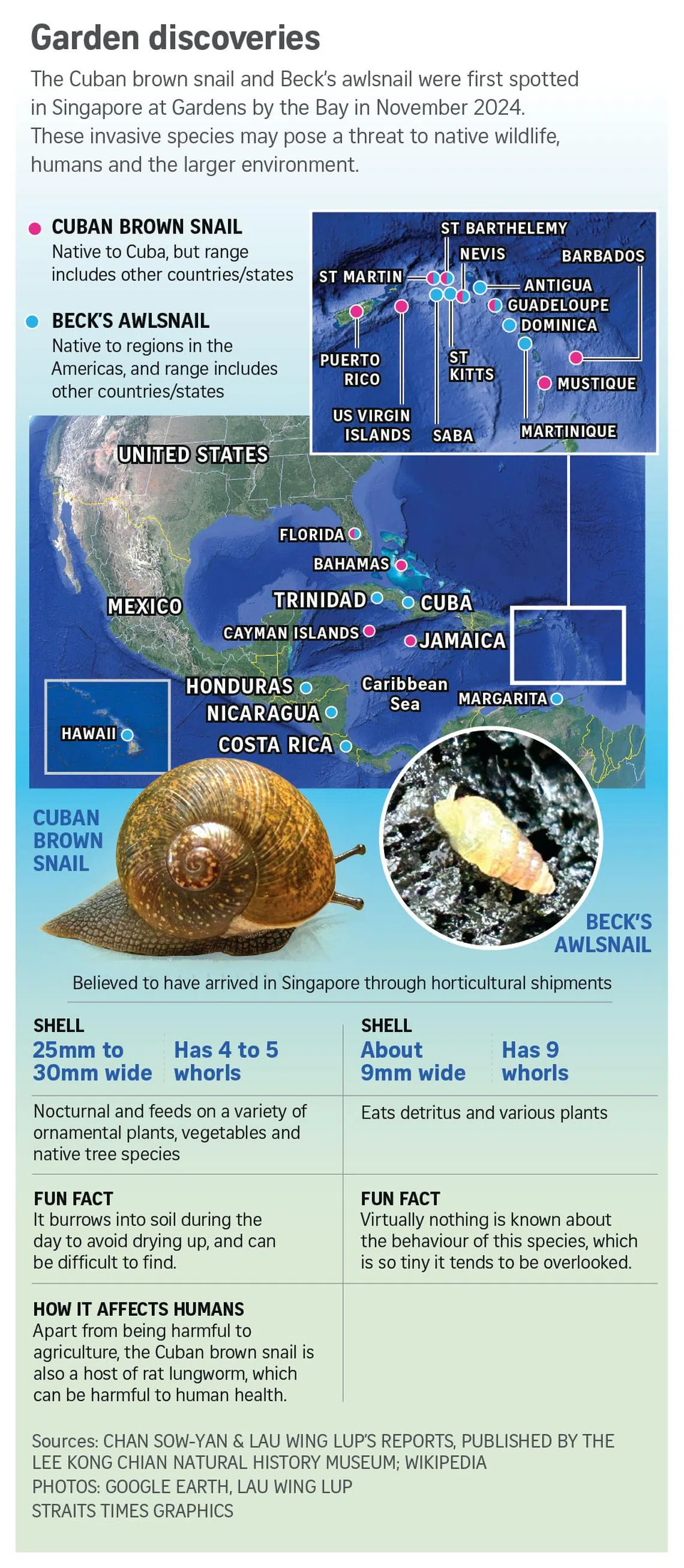Two new snail species found in Singapore and Asia for the first time, may harm local wildlife
Sign up now: Get ST's newsletters delivered to your inbox

The two snails are both non-native, and were thought to have been brought in via horticultural imports.
PHOTO: LAU WING LUP
Follow topic:
SINGAPORE - Two snail species – the Cuban brown snail and Beck’s awlsnail – have been spotted in Singapore for the first time.
This also marks their first sighting in Asia, reports by the Lee Kong Chian Natural History Museum said on Feb 28.
Prior to their discovery here, the Cuban brown snail (Zachrysia provisoria) and Beck’s awlsnail (Beckianum beckianum) had been documented in various locations in Central and South America, Hawaii and the Caribbean.
The reports on the snails, seen in November 2024 at Gardens by the Bay, were authored by Mr Chan Sow-Yan and Mr Lau Wing Lup.
The two nature enthusiasts are regular contributors to the museum’s journal, Nature in Singapore, where new biodiversity sightings in the Republic are documented.
Mr Lau, who works as a care manager in a home for the elderly, told The Straits Times that he found live specimens of the two snails after extensive searches and multiple visits to the Gardens.
“It took me a few day trips of active searching before I finally found a pair of Cuban brown snails – an adult and a juvenile alive and aestivating (in a dormant state) in the centre of a bird’s nest fern,” he said.
“It was a stroke of luck and my curiosity to look through that particular patch of leaf litter as there was no telltale sign of their presence.”
The specimens were identified by the two authors, who compared their appearance against photographs and descriptions of different snail species online and in scientific texts.
Both snails were likely to have been accidentally introduced via horticultural shipments, said the museum records. And according to museum staff, this seems to be part of a larger trend.
“Compared to the other groups of animals, there seems to be a disproportionately high number of introduced terrestrial and freshwater molluscs in Singapore,” said Mr Tan Siong Kiat, the collection manager of molluscs at the museum.
According to Mr Tan, there have been at least half a dozen terrestrial molluscs reported in Singapore for the first time in the past decade.
He said: “Most of the alien terrestrial snails and slugs found in Singapore are believed to have been introduced via the horticultural trade.
“Their eggs and young can be easily hidden among soil and foliage and if the conditions are favourable, a population can be established quite quickly and subsequently dispersed.”
Though it remains unclear whether a population of these two snail species has been established locally, the introduction of non-native species such as these may be harmful to local wildlife, the museum reports said.
“Unfortunately, it may take many years before we find out if any of the native snail species have been outcompeted, and it might be too late by then,” Mr Tan said.

Aside from posing a threat to their shelled counterparts, these non-native species may also be of risk to humans and the larger environment.
The Cuban brown snail, for instance, is a host of rat lungworm – a parasite that may impact human health and also has a detrimental impact on agriculture, said the reports.
More can be done to guard against the threat of invasive species in Singapore, Mr Tan said.
“With regard to these two snails, I am not aware of any long-term monitoring or whether there are any mitigation measures undertaken by the relevant agencies,” he added.
Echoing Mr Tan’s call, Mr Lau suggested that the quarantine and inspection of imported plants and animals to Singapore could be further enforced, and that more work is needed to determine the impact of such imports.
Singaporeans can also play a role by not releasing any exotic species into the country’s natural environment, he said.
Additionally, they can report any sightings of invasive flora and fauna to the Lee Kong Chian Natural History Museum, so that action can be taken to “curb the possible threats of these aliens”.


